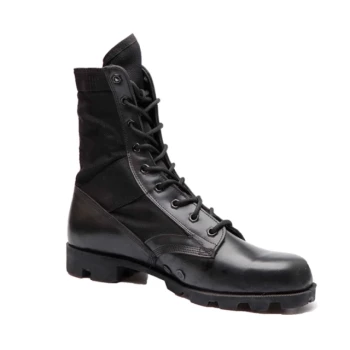Ensuring a proper fit for police boots is critical for comfort, performance, and injury prevention during long shifts. Officers should prioritize accurate measurements, realistic testing conditions (like trying boots on in the afternoon with duty socks), and gradual break-in periods. Key considerations include toe space, heel stability, and width snugness without constriction. Aftermarket insoles can further customize fit for individual arch support needs.
Key Points Explained:
-
Measure Accurately
- Use a Brannock device to determine foot length, width, and arch type.
- Re-measure periodically, as foot size can change over time due to age or weight fluctuations.
-
Timing Matters: Test Boots in the Afternoon
- Feet naturally swell later in the day; trying boots during this time ensures the fit accommodates swelling during shifts.
-
Wear Duty Socks During Fitting
- Thickness of work socks impacts fit. Testing boots with the same socks worn on duty prevents surprises in real-world use.
-
Toe and Heel Fit Guidelines
- Toe Space: Leave a thumb’s width (~1/2 inch) between the longest toe and boot end to prevent blisters or nail damage.
- Heel Stability: Heels should not slide; minimal movement prevents friction-related injuries.
-
Width and Arch Considerations
- Boots should feel snug but not pinch. Tight widths can cause bunions or numbness, while loose fits reduce support.
- Aftermarket insoles can address arch support gaps if the boot’s default insole is insufficient.
-
Test Mobility
- Walk, crouch, and simulate duty movements during fitting. Discomfort in the store will worsen during extended wear.
-
Break-In Period
- Gradually break in new boots over short periods to mold them to foot shape and avoid blisters.
- Use leather conditioners or stretching tools if needed for stiff materials.
-
Reassess Over Time
- Replace boots when soles wear down or if persistent discomfort arises, as degraded support increases injury risk.
By methodically addressing these factors, officers can optimize fit for durability, comfort, and performance in demanding environments.
Summary Table:
| Key Consideration | Guidance |
|---|---|
| Accurate Measurement | Use a Brannock device; re-measure periodically for changes. |
| Test Timing | Try boots in the afternoon to account for foot swelling. |
| Duty Socks | Wear the same socks used on duty during fitting. |
| Toe Space | Leave ~1/2 inch between longest toe and boot end. |
| Heel Stability | Ensure minimal heel slippage to prevent friction injuries. |
| Width & Arch Fit | Snug but not tight; use aftermarket insoles for arch support if needed. |
| Mobility Test | Simulate duty movements (walking, crouching) during fitting. |
| Break-In Period | Gradually wear boots over short sessions to mold them to your feet. |
| Replacement | Replace boots when soles wear or discomfort persists to avoid injuries. |
Need Reliable Police Boots Tailored for Duty?
As a large-scale manufacturer, 3515 produces high-performance police boots designed for durability, support, and all-day comfort. Our boots are trusted by distributors, law enforcement agencies, and bulk buyers worldwide.
Contact us today to discuss custom solutions or bulk orders—let’s equip your team with footwear built for the demands of the job.
Related Products
- Durable Mid-Cut Tactical Boots for Wholesale & Private Label
- Wholesale Durable Mid-Cut Tactical Boots for Custom & Private Label Brands
- Durable Military Combat Boots with Water Drainage for Wholesale & OEM
- Wholesale High-Traction Camo Boots - Custom Manufacturer for Brands
- Wholesale Classic Leather Lace-Up Ankle Boots for Brand Manufacturing
People Also Ask
- Are tactical boots suitable for urban environments? Discover Their Versatility for City Life
- Can tactical boots be used for everyday wear? Discover Their Versatility & Comfort
- Do all tactical boots have steel toes? Exploring Modern Safety Footwear Options
- Are tactical boots suitable for hiking? Key Factors for Trail Performance
- Why is footwear important in tactical situations? Boost Performance & Safety with Tactical Boots












